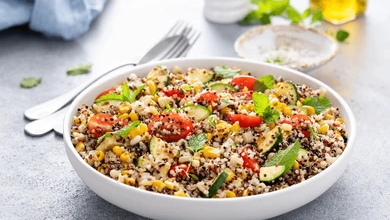Cook Healthy Meals Without Sacrificing Flavor: 10 Practical Tips
Learn 10 tips to cook healthy meals without sacrificing flavor. Balance nutrition and taste with easy strategies and delicious recipes.

Cooking healthy meals often seems like a compromise between nutrition and taste. However, with the right techniques and ingredients, you can enjoy delicious, flavorful meals that are also good for you. Here are 10 practical tips to help you cook healthy meals without sacrificing flavor.
Tip 1: Use Fresh, Quality Ingredients
Why Fresh Ingredients Matter
Fresh ingredients are packed with nutrients and natural flavors that can elevate any dish. When produce is fresh, it retains more vitamins, minerals, and antioxidants, which are essential for a healthy diet. Fresh vegetables and fruits also have a more vibrant taste and texture compared to canned or frozen ones.
Where to Source Quality Ingredients
To ensure you’re getting the best ingredients, shop at local farmers’ markets or buy organic produce. Look for seasonal fruits and vegetables, as they are typically fresher and more flavorful. When shopping, check the produce for ripeness and freshness. Buying from local sources not only supports local farmers but also ensures you get produce that hasn’t traveled long distances, preserving its nutrient content and taste.
Tip 2: Experiment with Herbs and Spices
Spice Combinations for Different Cuisines
Herbs and spices are the secret to adding depth and richness to your meals without extra calories. Experiment with combinations like basil and oregano for Italian dishes, cumin and coriander for Indian flavors, or thyme and rosemary for a Mediterranean touch. Don’t be afraid to mix and match; the right blend can transform a simple dish into a gourmet experience.
Benefits of Using Herbs
Not only do herbs and spices enhance flavor, but many also have health benefits. For example, turmeric has anti-inflammatory properties, garlic can boost your immune system, and ginger can aid digestion. Fresh herbs like parsley, cilantro, and dill can add a burst of freshness to any dish, making it more appealing and enjoyable.
Practical Tips for Using Herbs and Spices
To get the most flavor from your herbs and spices, store them properly. Keep dried spices in a cool, dark place, and use fresh herbs within a few days of purchase. Crushing dried herbs in your hand before adding them to a dish can help release their essential oils and enhance their flavor.
Tip 3: Choose Healthy Cooking Methods
Steaming vs. Frying: Health Benefits
Steaming, baking, grilling, and roasting are healthier cooking methods compared to frying. These techniques help retain nutrients and reduce the need for added fats. Steaming vegetables, for instance, helps preserve their vitamins and minerals better than boiling.
Grilling Tips for Healthier Meals
When grilling, use lean cuts of meat and plenty of vegetables. Marinate meats with herbs and spices to enhance flavor and avoid using sugary sauces. You can also grill fruits like pineapple or peaches for a healthy dessert option.
Benefits of Roasting and Baking
Roasting vegetables can bring out their natural sweetness and add a delicious caramelized flavor. Baking is another healthy option for cooking fish, chicken, and even vegetables. Using parchment paper or silicone baking mats can help reduce the need for additional oils and fats.
Tip 4: Balance Macronutrients
Understanding Macronutrients
A balanced meal should include the right proportions of carbohydrates, proteins, and fats. Each macronutrient plays a crucial role in maintaining energy levels and overall health. Carbohydrates provide energy, proteins support muscle repair and growth, and fats are essential for cell function and nutrient absorption.
How to Balance Your Plate
Fill half your plate with vegetables, a quarter with lean protein, and the remaining quarter with whole grains. This simple method ensures a balanced intake of essential nutrients. For example, a balanced meal could be grilled chicken breast with quinoa and a side of steamed broccoli and carrots.
Incorporating Variety
Variety is key to a balanced diet. Include different types of vegetables, proteins, and grains in your meals to ensure you’re getting a wide range of nutrients. Try to incorporate plant-based proteins like beans, lentils, and tofu for added variety and health benefits.
Tip 5: Incorporate Colorful Vegetables
Nutrient-Rich Vegetables
Vegetables of different colors provide a range of nutrients. For example, leafy greens are high in iron and calcium, while red and orange vegetables are rich in vitamins A and C. Each color represents different phytonutrients that offer unique health benefits.
Creative Ways to Add Vegetables
Add vegetables to soups, stews, and casseroles. Try spiralizing zucchini for a low-carb pasta alternative or blending spinach into smoothies for a nutrient boost. You can also make vegetable-based sauces or dips, like a roasted red pepper hummus or a creamy avocado dressing.
Roasting and Grilling Vegetables
Roasting and grilling can bring out the natural sweetness in vegetables. Try roasting a mix of root vegetables like carrots, sweet potatoes, and beets with a drizzle of olive oil and your favorite herbs. Grilled vegetables like bell peppers, zucchini, and asparagus make great sides or additions to salads and wraps.
Tip 6: Opt for Whole Grains
Types of Whole Grains
Whole grains like quinoa, brown rice, oats, and barley are packed with fiber and nutrients. They provide sustained energy and can help improve digestion. Unlike refined grains, whole grains retain their bran and germ, which contain essential nutrients and fiber.
Recipes Using Whole Grains
Swap refined grains for whole grains in your recipes. Use quinoa instead of white rice, or whole wheat flour instead of all-purpose flour in baking. You can also try making grain salads with ingredients like farro, bulgur, and wild rice, mixed with fresh vegetables and a light vinaigrette.
Benefits of Whole Grains
Whole grains are linked to a lower risk of heart disease, diabetes, and certain cancers. They also help keep you feeling full longer, which can aid in weight management. Incorporating a variety of whole grains into your diet ensures you get a broad spectrum of nutrients.
Tip 7: Reduce Added Sugars
Natural Sweeteners Alternatives
Cutting back on added sugars can significantly improve your diet. Use natural sweeteners like honey, maple syrup, or dates as alternatives. These options provide sweetness along with additional nutrients that refined sugars lack.
Reducing Sugar in Baking
Try using mashed bananas, applesauce, or pureed fruits to sweeten baked goods naturally. These alternatives add moisture and flavor without the extra sugar. You can also reduce the amount of sugar called for in recipes by one-third to one-half without significantly affecting the taste or texture.
Reading Labels
Be mindful of hidden sugars in processed foods. Check ingredient labels for added sugars, which can appear under many different names, such as high-fructose corn syrup, sucrose, and dextrose. Choosing whole, unprocessed foods helps minimize your intake of hidden sugars.
Tip 8: Healthy Fats are Essential
Benefits of Healthy Fats
Healthy fats, such as those found in avocados, nuts, seeds, and olive oil, are essential for brain health and can help reduce inflammation. These fats also play a crucial role in the absorption of fat-soluble vitamins like A, D, E, and K.
Cooking with Healthy Oils
Use olive oil or avocado oil for cooking instead of butter or margarine. These oils are rich in monounsaturated fats, which are good for heart health. Coconut oil is another option that adds a subtle flavor to dishes and has a high smoke point, making it suitable for high-heat cooking.
Incorporating Nuts and Seeds
Add nuts and seeds to salads, yogurt, and oatmeal for an extra boost of healthy fats and protein. Almonds, walnuts, chia seeds, and flaxseeds are all excellent choices. Nut butters, like almond or peanut butter, can also be a nutritious addition to smoothies or as a spread.
Tip 9: Portion Control Matters
Importance of Portion Sizes
Eating the right portion sizes helps prevent overeating and ensures you get the right amount of nutrients without excess calories. Oversized portions can lead to weight gain and other health issues, even if the food itself is healthy.
Tips for Controlling Portions
Use smaller plates to help manage portion sizes. Measure out servings instead of eating directly from the package, and be mindful of your hunger cues. Eating slowly and savoring your food can also help you recognize when you’re full.
Mindful Eating Practices
Practice mindful eating by paying attention to what and how much you eat. Avoid distractions like TV or smartphones during meals, and focus on the flavors, textures, and aromas of your food. This practice can help you enjoy your meals more and prevent overeating.
Tip 10: Plan Your Meals Ahead
Meal Planning for Busy Schedules
Planning meals ahead of time can help you make healthier choices and avoid last-minute unhealthy options. Create a weekly meal plan and grocery list to stay organized. Include a variety of meals to keep things interesting and ensure a balanced diet.
How to Batch Cook and Store Meals
Prepare large batches of meals and store them in individual portions. This approach saves time and ensures you always have a healthy meal ready to go. Invest in quality storage containers to keep your food fresh and make reheating easy.
Freezer-Friendly Meals
Many meals can be prepared ahead and frozen for later use. Soups, stews, casseroles, and cooked grains freeze well and can be quickly reheated for a convenient and healthy meal. Label your containers with the date and contents to keep track of what you have on hand.
Cooking healthy meals without sacrificing flavor is achievable with the right strategies and ingredients. By incorporating these 10 tips into your cooking routine, you can enjoy delicious, nutritious meals that support your health and well-being. Start experimenting with fresh ingredients, herbs, and healthy cooking methods today, and discover the joy of eating well without compromising on taste. Whether you’re a seasoned cook or a kitchen novice, these tips will help you create meals that are both satisfying and nourishing.
Check out our Healthy and Flavorful Quinoa Salad Recipe for a perfect example of how to cook a nutritious and tasty meal using fresh, quality ingredients and vibrant vegetables.
For readers looking to dive deeper into the art of cooking healthy meals without sacrificing flavor, I highly recommend “The Flavor Bible” by Karen Page and Andrew Dornenburg. This comprehensive guide offers invaluable insights into how to creatively combine ingredients to enhance flavor while maintaining nutritional value. It’s an essential resource for anyone eager to elevate their cooking skills and explore new, delicious ways to prepare healthy meals. Happy cooking!
Questions and Answers (QAR)
Question: Why do fresh ingredients matter when cooking healthy meals? Answer: Fresh ingredients matter because they are packed with nutrients and natural flavors that elevate any dish. Fresh produce retains more vitamins, minerals, and antioxidants, which are essential for a healthy diet. They also have a more vibrant taste and texture compared to canned or frozen ones.
Question: Where can you source quality ingredients? Answer: You can source quality ingredients from local farmers’ markets or by buying organic produce. Seasonal fruits and vegetables are typically fresher and more flavorful. It’s important to check the produce for ripeness and freshness when shopping.
Question: What are some healthy cooking methods that retain nutrients? Answer: Steaming, baking, grilling, and roasting are healthier cooking methods that help retain nutrients and reduce the need for added fats. Steaming vegetables, for instance, preserves their vitamins and minerals better than boiling.
Question: How should you balance macronutrients in a meal? Answer: A balanced meal should include the right proportions of carbohydrates, proteins, and fats. Fill half your plate with vegetables, a quarter with lean protein, and the remaining quarter with whole grains to ensure a balanced intake of essential nutrients.
Question: Why should you opt for whole grains instead of refined grains? Answer: Whole grains are packed with fiber and nutrients, providing sustained energy and improving digestion. Unlike refined grains, whole grains retain their bran and germ, which contain essential nutrients and fiber.
Question: What are some alternatives to added sugars? Answer: Natural sweeteners like honey, maple syrup, or dates can be used as alternatives to added sugars. These options provide sweetness along with additional nutrients that refined sugars lack.
Question: Why are healthy fats essential in a diet? Answer: Healthy fats, such as those found in avocados, nuts, seeds, and olive oil, are essential for brain health and help reduce inflammation. They also play a crucial role in the absorption of fat-soluble vitamins like A, D, E, and K.




